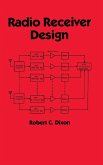- Broschiertes Buch
- Merkliste
- Auf die Merkliste
- Bewerten Bewerten
- Teilen
- Produkt teilen
- Produkterinnerung
- Produkterinnerung
Learn the key concepts and get hands-on experience with this step-by-step guide to constructing a fully functioning software receiver.
Andere Kunden interessierten sich auch für
![Software Receiver Design Software Receiver Design]() C. Richard JohnsonSoftware Receiver Design144,99 €
C. Richard JohnsonSoftware Receiver Design144,99 €![Iterative Receiver Design Iterative Receiver Design]() Henk WymeerschIterative Receiver Design82,99 €
Henk WymeerschIterative Receiver Design82,99 €![Modern Communications Receiver Design a Modern Communications Receiver Design a]() Cornell DrenteaModern Communications Receiver Design a157,99 €
Cornell DrenteaModern Communications Receiver Design a157,99 €![Design of LNA using 0.18 um CMOS Technology for Receiver Front End Design of LNA using 0.18 um CMOS Technology for Receiver Front End]() Roopal LambaDesign of LNA using 0.18 um CMOS Technology for Receiver Front End32,99 €
Roopal LambaDesign of LNA using 0.18 um CMOS Technology for Receiver Front End32,99 €![Radio Receiver Design Radio Receiver Design]() Robert DixonRadio Receiver Design348,99 €
Robert DixonRadio Receiver Design348,99 €![Techniques and System Design of Radar Active Jamming Techniques and System Design of Radar Active Jamming]() Guangfu TangTechniques and System Design of Radar Active Jamming121,99 €
Guangfu TangTechniques and System Design of Radar Active Jamming121,99 €![Techniques and System Design of Radar Active Jamming Techniques and System Design of Radar Active Jamming]() Guangfu TangTechniques and System Design of Radar Active Jamming121,99 €
Guangfu TangTechniques and System Design of Radar Active Jamming121,99 €-
-
-
Learn the key concepts and get hands-on experience with this step-by-step guide to constructing a fully functioning software receiver.
Produktdetails
- Produktdetails
- Verlag: Cambridge University Press
- Seitenzahl: 480
- Erscheinungstermin: 27. Juni 2014
- Englisch
- Abmessung: 244mm x 170mm x 26mm
- Gewicht: 821g
- ISBN-13: 9780521189446
- ISBN-10: 0521189446
- Artikelnr.: 33353715
- Herstellerkennzeichnung
- Libri GmbH
- Europaallee 1
- 36244 Bad Hersfeld
- gpsr@libri.de
- Verlag: Cambridge University Press
- Seitenzahl: 480
- Erscheinungstermin: 27. Juni 2014
- Englisch
- Abmessung: 244mm x 170mm x 26mm
- Gewicht: 821g
- ISBN-13: 9780521189446
- ISBN-10: 0521189446
- Artikelnr.: 33353715
- Herstellerkennzeichnung
- Libri GmbH
- Europaallee 1
- 36244 Bad Hersfeld
- gpsr@libri.de
C. Richard Johnson, Jr is the Geoffrey S. M. Hedrick Senior Professor of Engineering at Cornell University, where he has been on the faculty since 1981. He is a Fellow of the IEEE and co-author of Telecommunication Breakdown (2004, with William A. Sethares) and Theory and Design of Adaptive Filters (2001).
Part I. The Big Picture: 1. A digital radio
Part II. The Basic Components: 2. A telecommunication system
3. The six elements
Part III. The Idealized System: 4. Funny things
5. Analog (de)modulation
6. Sampling with automatic gain control
7. Digital filtering and the DFT
8. Bits to symbols to signals
9. Stuff happens
Part IV. The Adaptive Components: 10. Carrier recovery
11. Pulse shaping and receive filtering
12. Timing recovery
13. Linear equalization
14. Coding
Part V. Putting it All Together: 15. Make it so
A. Transforms, identities, and formulas
B. Simulating noise
C. Envelope of a bandpass signal
D. Relating the Fourier transform to the DFT
E. Power spectral density
F. The Z-transform: difference equations, frequency responses, open eyes, and loops
G. Averages and averaging
H. The B3IG transmitter.
Part II. The Basic Components: 2. A telecommunication system
3. The six elements
Part III. The Idealized System: 4. Funny things
5. Analog (de)modulation
6. Sampling with automatic gain control
7. Digital filtering and the DFT
8. Bits to symbols to signals
9. Stuff happens
Part IV. The Adaptive Components: 10. Carrier recovery
11. Pulse shaping and receive filtering
12. Timing recovery
13. Linear equalization
14. Coding
Part V. Putting it All Together: 15. Make it so
A. Transforms, identities, and formulas
B. Simulating noise
C. Envelope of a bandpass signal
D. Relating the Fourier transform to the DFT
E. Power spectral density
F. The Z-transform: difference equations, frequency responses, open eyes, and loops
G. Averages and averaging
H. The B3IG transmitter.
Part I. The Big Picture: 1. A digital radio
Part II. The Basic Components: 2. A telecommunication system
3. The six elements
Part III. The Idealized System: 4. Funny things
5. Analog (de)modulation
6. Sampling with automatic gain control
7. Digital filtering and the DFT
8. Bits to symbols to signals
9. Stuff happens
Part IV. The Adaptive Components: 10. Carrier recovery
11. Pulse shaping and receive filtering
12. Timing recovery
13. Linear equalization
14. Coding
Part V. Putting it All Together: 15. Make it so
A. Transforms, identities, and formulas
B. Simulating noise
C. Envelope of a bandpass signal
D. Relating the Fourier transform to the DFT
E. Power spectral density
F. The Z-transform: difference equations, frequency responses, open eyes, and loops
G. Averages and averaging
H. The B3IG transmitter.
Part II. The Basic Components: 2. A telecommunication system
3. The six elements
Part III. The Idealized System: 4. Funny things
5. Analog (de)modulation
6. Sampling with automatic gain control
7. Digital filtering and the DFT
8. Bits to symbols to signals
9. Stuff happens
Part IV. The Adaptive Components: 10. Carrier recovery
11. Pulse shaping and receive filtering
12. Timing recovery
13. Linear equalization
14. Coding
Part V. Putting it All Together: 15. Make it so
A. Transforms, identities, and formulas
B. Simulating noise
C. Envelope of a bandpass signal
D. Relating the Fourier transform to the DFT
E. Power spectral density
F. The Z-transform: difference equations, frequency responses, open eyes, and loops
G. Averages and averaging
H. The B3IG transmitter.









